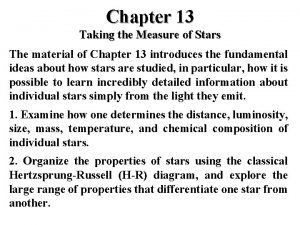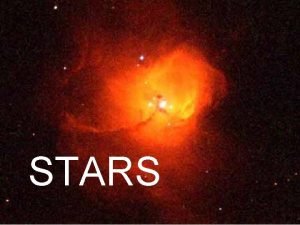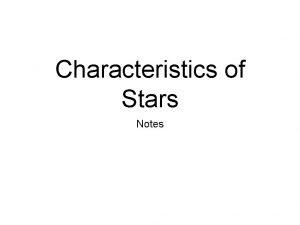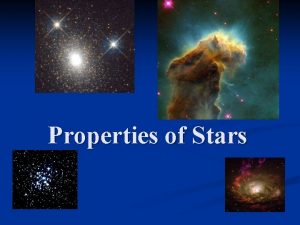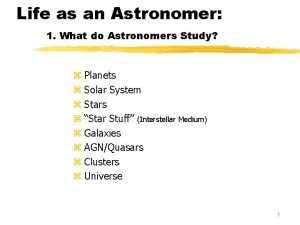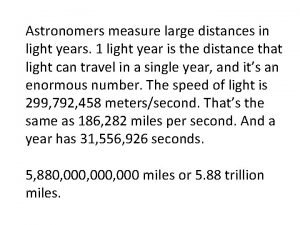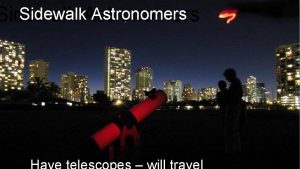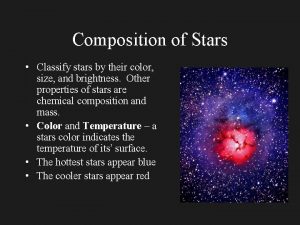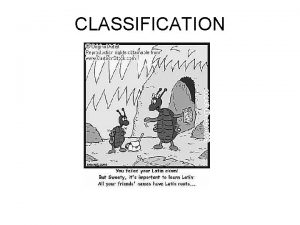STAR CLASSIFICATION STAR CLASSIFICATION Astronomers classify stars primarily











- Slides: 11

STAR CLASSIFICATION

STAR CLASSIFICATION • Astronomers classify stars primarily according to colour, temperature, and brightness. Astronomers have discovered that colour and temperature are related. • Hot starts tend to appear blue • Cool start tend to appear red. • Because these two factors are related, astronomers combine these two factors to determine the star’s spectral class. Spectral types are represented with letters.

THIS TABLE SUMMARIZES STAR SPECTRAL TYPES: Type Colour Temperature O Blue 30, 000 – 60, 000 ˚C Red Less than 3, 500 ˚C B A F G K M

A STAR’S COLOUR • A star’s colour can tell us many things. The colour of the star can indicate how hot the start is (as shown above), what elements the star is made of, and if the star is moving towards or away from Earth. • Astronomers use a spectroscope to split the light coming from a star into spectrum. Because each element produces a unique pattern of lines on the spectrum, astronomer can identify which elements are present in a start.

• The lines places on a spectrum from a particular element are always spaced the same distance apart, but sometimes do not occur on top of the colour they should be. This is caused by the Doppler Effect. • Just like a duck paddling through water causes ripples to be compressed in front and expanded behind, a star’s motion affects the wavelengths of light it releases. Sound or light can be affected by the Doppler Effect – compressed or stretched.

• If the star is moving towards Earth the wavelengths are compressed and the lines on the spectrum will be shifted towards the blue end of the spectrum. This is called a blue shift. • If the star is moving away from Earth the wavelengths are stretched and the lines on the spectrum will be shifted toward the red end of the spectrum. This is called a red shift.

• If astronomers measure the frequency and the wavelength of the light emitted from the star AND the amount of shift they can determine the speed of the star. • Astronomers also describe starts according to how bright they are. Two factors affect how bright a start appears from Earth: • How much energy the star emits • How close the star is from Earth

• To ease confusion which discussing brightness, astronomers have split this characteristics into two types: • Absolute Magnitude: a measure of the actual amount of energy emitted from the star. Distance from Earth does not affect this measurement. • Apparent Magnitude: a measure of how bright a star appears in the night sky when compared to other starts. This observation is affected by both the actual magnitude and the starts distance from Earth.

• They spectral type and absolute magnitude of a star are related. Astronomers have illustrated this relationship in a graph called the Hertsprung-Russel Diagram. • The Hertsprung-Russel Diagram not only shows the temperature, colour and magnitude each star type, but also can show the progression of a star’s characteristics through is lifespan.


 Astronomers measure the masses of stars by
Astronomers measure the masses of stars by There are three sizes of schnauzer dog
There are three sizes of schnauzer dog How do scientists classify stars
How do scientists classify stars Characteristics used to classify stars
Characteristics used to classify stars How do we classify stars
How do we classify stars What is classification of plant
What is classification of plant Star of wonder star of night star of royal beauty bright
Star of wonder star of night star of royal beauty bright What do astronomers study
What do astronomers study Modern telescopes make it possible for astronomers
Modern telescopes make it possible for astronomers Astronomers measure large distances in light years
Astronomers measure large distances in light years Difference between a star and ao star
Difference between a star and ao star Star events stands for
Star events stands for
